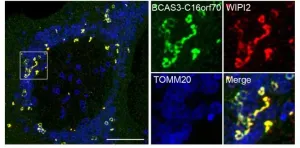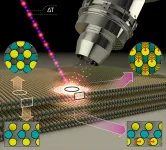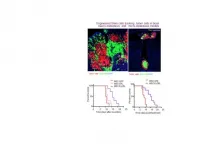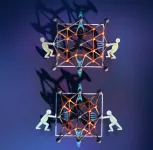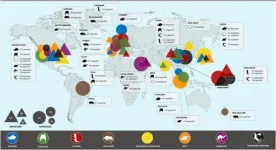Light in concert with force reveals how materials become harder when illuminated
When indented by a probe in darkness, wafers of some semiconductors are putty-like. When illuminated by light whose wavelength matches the band gap, they become hard, as electrons and holes freed by the light suppress the propagation of dislocations
2021-03-05
(Press-News.org) Semiconductor materials play an indispensable role in our modern information-oriented society. For reliable performance of semiconductor devices, these materials need to have superior mechanical properties: they must be strong as well as resistant to fracture, despite being rich in nanoscale structures.
Recently, it has become increasingly clear that the optical environment affects the structural strength of semiconductor materials. The effect can be much more significant than expected, especially in light-sensitive semiconductors, and particularly since due to technological constraints or fabrication cost many semiconductors can only be mass-produced in very small and thin sizes. Moreover, laboratory testing of their strength has generally been performed on large samples. In the light of the recent explosion in emerging nanoscale applications, all of this suggests that there is an urgent need for the strength of semiconductor materials to be reappraised under controlled illumination conditions and thin sample sizes.
To this end, Professor Atsutomo Nakamura's group at Nagoya University, Japan, and Dr. Xufei Fang's group at the Technical University of Darmstadt have developed a technique for quantitatively studying the effect of light on nanoscale mechanical properties of thin wafers of semiconductors or any other crystalline material. They call it a "photoindentation" method. Essentially, a tiny, pointy probe indents the material while it is illuminated by light under controlled conditions, and the depth and rate at which the probe indents the surface can be measured. The probe creates dislocations - slippages of crystal planes - near the surface, and using a transmission electron microscope the researchers observe the effect of light at a range of wavelengths on dislocation nucleation (the birth of new dislocations) and dislocation mobility (the dislocations' gliding or sliding away from the point where they were created). The nucleation and mobility are measured separately for the first time and is one of the novelties of the photoindentation technique.
The researchers have discovered that while light has a marginal effect on the generation of dislocations under mechanical loading, it has a much stronger effect on the motion of dislocations. When a dislocation occurs, it is energetically favorable for it to expand and join up (nucleate) with others, and the imperfection gets bigger. Illumination by light does not affect this: the electrons and holes excited in the semiconductor by the light (the "photo-excited carriers") do not affect the strain energy of the dislocation, and it is this energy that determines the "line tension" of the dislocation that controls the nucleation process.
On the other hand, dislocations can also move in a so-called "glide motion", during which photo-excited carriers are dragged by dislocations via electrostatic interaction. The effect of photo-excited carriers on this dislocation motion is much more pronounced: if enough carriers are produced, the material becomes much stronger.
This effect is strikingly demonstrated when the same experiment is carried out in complete darkness and then under illumination with light at a wavelength that matches the semiconductor band gap (which produces an increased number of photo-excited carriers). When indented, any solid material initially undergoes "plastic deformation" - changing shape without springing back, somewhat like putty - until the load becomes too great, upon which it cracks. The Nagoya University research group demonstrated that the inorganic semiconductor zinc sulfide (ZnS) in total darkness behaves somewhat like putty, deforming by a huge 45% under shear strain without cracking or falling apart. However, when illuminated at the correct wavelength, it becomes quite hard. At other wavelengths it becomes not quite as hard.
The new findings demonstrate that purely plastic deformation without crack formation in semiconductor materials occurs at the nanoscale. With regards to mechanical behaviour, these semiconductors therefore resemble metallic materials. This newly established, robust experimental protocol makes it possible to evaluate the effect of light on the strength of even non-semiconducting materials that are very thin. Professor Nakamura notes: "One particularly important aspect is that non-semiconductors can exhibit semiconducting properties near the surface, due to oxidation, for instance, and since the starting point of deformation or fracture is often the surface, it is of great significance to establish a method for accurately measuring the strength of materials under controlled illumination conditions at the very surface, on a nanoscale."
The hardening effect that electron-hole pairs freed by light illumination have on material strength - by suppressing the propagation of dislocations, particularly near the surface - is part of a paradigm shift in the science of material strength. Conventionally, when considering the strength of a material, the atomic arrangement was the smallest unit. In other words, there was a premise that the strength of the material could be understood from the atomic arrangement and elasticity theory. However, recent studies have reported that the strength characteristics of materials change significantly due to external influences such as light and an electric field. Therefore, Professor Nakamura notes, "it is becoming more and more accepted that other viewpoints must be added to the theory of material strength which include the motion of electrons and holes that are smaller than atoms."
"This study reaffirms the quantum-level effect on the strength of such materials. In this respect, it can be said that this research has achieved one milestone in the paradigm shift in the field of material strength that is currently occurring."
Dr. Xufei Fang adds: "Now that the creation of devices on the true nanoscale is becoming a reality, the impact of light on the structural strength of various inorganic semiconductors is an issue to be considered."
INFORMATION:
Funding information: This study was mainly supported by JST PRESTO (Grant Number JPMJPR199A). A part of this study was financially supported by JSPS KAKENHI (Grant Numbers JP17H06094, JP18H03840, JP19H05786, JP19K22050) and Athene Young Investigator Programme from TU Darmstadt, Germany.
[Attachments] See images for this press release:
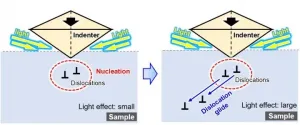
ELSE PRESS RELEASES FROM THIS DATE:
2021-03-05
Background: Although caregivers of patients with eating disorders usually experience a heavy caregiving burden, the effects of social support on caregivers of patients with eating disorders are unknown. This study aimed to investigate how social support for mothers who are caregivers of patients with an eating disorder improves the mothers' mental status and, consequently, the symptoms and status of the patients.
Methods: Fifty-seven pairs of participants were recruited from four family self-help groups and one university hospital in Japan. Recruitment was conducted from July 2017 to August 2018. Mothers were ...
2021-03-05
Autophagy is an intracellular degradation process of cytosolic materials and damaged organelles. Researchers at Ubiquitin Project of TMIMS have been studying the molecular mechanism of mitophagy, the selective autophagy process to eliminate damaged mitochondria. PINK1 (a serine/threonine kinase) and Parkin (a ubiquitin ligating enzyme: E3) work together to ubiquitylate the outer membrane proteins of damaged mitochondria, then ubiquitin chains are recognized as signals for autophagy degradation. Dysfunction of mitophagy causes a decrease in mitochondrial quality with overproduction of ROS, and is linked to neurodegenerative diseases like Parkinson's disease.
In Autophagy machinery, cellular components targeted for degradation are engulfed by phosphatidylinositol-3-phosphate (PI3P)-rich ...
2021-03-05
Frequently occurring chronic skin inflammation like in atopic dermatitis (AD or neurodermatitis) and psoriasis have different causes such as genetic predisposition, stress or allergens. These frequently occurring skin diseases are mostly attributed by biomedical scientists to a disturbed immune system, although the noticeable thickening and flaking of the epidermis, which is the outermost layer of skin, also indicates a disruption of the epithelial cells. A team of researchers from the University Clinic for Dermatology and the Clinical Institute for Laboratory Medicine at MedUni Vienna has now been able to identify new molecular ...
2021-03-05
WHO: Giovanni Traverso, MB, BChir, PhD, Associate Physician, Division of Gastroenterology, Brigham and Women's Hospital; corresponding author of a new article published in JAMA Network Open.
Peter Chai, MD, MMS, Assistant Professor, Department of Emergency Medicine, Brigham and Women's Hospital; first author.
WHAT: In the age of COVID-19, mobile robotic telehealth systems could help clinicians and patients interact without contact. Last spring, some health care systems deployed robotic systems within a hospital to evaluate and interact with patients. In a JAMA Network Open article, Traverso and colleagues report the results of a national survey and a cohort study in an emergency department (ED), which analyzed patients' satisfaction with an initial evaluation ...
2021-03-05
MoS2 thin films of superposed alternating layers of molybdenum and sulfur atoms form a two-dimensional semiconducting surface. However, even a surprisingly low-intensity blue light pulse is enough to alter the properties of the surface and make it metallic. This has now been demonstrated by a team at BESSY II.
The exciting thing is that the MoS2 layers in this metallic phase are also particularly active catalytically. They can then be employed, for example, as catalysts for splitting of water into hydrogen and oxygen. As inexpensive catalysts, they could facilitate the production of hydrogen - an energy ...
2021-03-05
Approximately 15-to-30 percent of patients with metastatic breast cancer have brain metastasis (BM), with basal-like breast cancer (BLBC) metastasizing to the brain most frequently. The prognosis for BLBC-BM patients is poor, as the blood-brain barrier prevents most therapeutics from reaching the brain. Testing candidate therapies in clinical trials is also challenging because animal models that mimic BM are limited. In a new study, researchers from Brigham and Women's Hospital and collaborators engineered a bimodal tumor-suppressing and killing molecule that can be delivered to the brain by stem cells. They tested ...
2021-03-05
Beijing, 26 February 2021: the journal Cardiovascular Innovations and Applications (CVIA) has just published the third issue of Volume 5. This issue brings together important research from authors in the USA and China, including several important papers concerned with the various cardiological implications of COVID-19.
Papers in the issue are as follows.
RESEARCH PAPERS
Diyu Cui, Yimeng Liao, Jianlin Du and Yunqing Chen
A Meta-analysis of Major Complications between Traditional Pacemakers and Leadless Pacemakers
(http://ow.ly/CgYO30rz3eA)
Yue Wu, Guoyue Zhang, Rong Hu and Jianlin Du
Risk of Target Organ Damage in Patients with Masked Hypertension versus
Sustained Hypertension: A Meta-analysis (http://ow.ly/x63E30rzjEp)
Jing Li, Lijie Sun, Fang Wang, Bing Liu, Hui Li, Guodong ...
2021-03-05
If you stretch an elastic band, it becomes thinner - a physical behavior that applies to most "common" materials. Since the 20th century, an opposite behavior has been known in materials research: The so-called auxetic (from ancient Greek auxetos, meaning 'stretchable') materials expand in the direction orthogonal to the strain. Likewise, they shrink when they are compressed. Scientifically, they are characterized by a negative Poisson's ratio. Probably the best known and oldest application of unusual Poisson's ratios is the bottle cork, which has a Poisson's ratio of zero. This has the effect that the cork ...
2021-03-05
Biodiversity is declining at an unprecedented rate, due primarily to human activity. Illegal and unsustainable wildlife trade is one of the major drivers of these declines, while much wildlife trade is legal, and the quantity of trade provides the opportunity to launder illegally sourced and traded species and products.
Researchers from the Conservation Forensics Lab at HKU and Research Division for Ecology and Biodiversity, analyzed trends in global legal wildlife trade from 1997 to 2016, and revealed that legal wildlife trade averaged $220 billion per year over this period, approximately double the international trade in tea, coffee and spices, and eclipsing - by order of magnitude - annual trade in trafficked wildlife, estimated ...
2021-03-05
Less than one-third of COVID-19 clinical trials are led by women, which is half the proportion observed in non-COVID-19 trials, according to research led by Queen Mary University of London, University of St Andrews, Brigham and Women's Hospital and Harvard Medical School.
The study suggests that gender disparities during the pandemic may signify not only a lack of women's leadership in international clinical trials and new research projects, but also may expose the imbalances in women's access to research activities and funding during health emergencies.
The results of the study are being publicised to mark International Women's Day on Monday 8 March. This ...
LAST 30 PRESS RELEASES:
[Press-News.org] Light in concert with force reveals how materials become harder when illuminated
When indented by a probe in darkness, wafers of some semiconductors are putty-like. When illuminated by light whose wavelength matches the band gap, they become hard, as electrons and holes freed by the light suppress the propagation of dislocations

